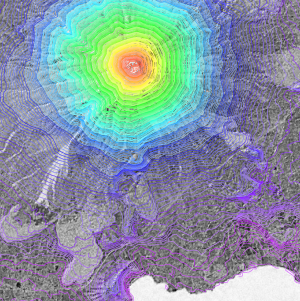Category:Digital Elevation Models: Difference between revisions
No edit summary |
m (Minor spellings) |
||
| Line 1: | Line 1: | ||
[[Category:Online Data]] | [[Category:Online Data]] | ||
[[File:ExampleSRTM.png|right|thumb|300px|Satellite Image with DEM Overlay. The image shows a part of the Ometepe Island in Lake Nicaragua with SRTM height contour data.]]The digital height models in WindPRO are based on open internet resources. | [[File:ExampleSRTM.png|right|thumb|300px|Satellite Image with DEM Overlay. The image shows a part of the Ometepe Island in Lake Nicaragua with SRTM height contour data.]]The digital height models in WindPRO are based on open internet resources. The best globally-available DHM source remains the Shuttle Radar Topography Mission (SRTM) data, but more countries (beyond the US) are releasing national data under free-data licenses. Typically these have a much better resolution than SRTM. | ||
== Considerations == | == Considerations == | ||
When using the remote sensing digital height models, you must manually consider the accuracy of the dataset used. This is especially important in the vicinity of the wind farm and | When using the remote sensing digital height models, you must manually consider the accuracy of the dataset used. This is especially important in the vicinity of the wind farm and other associated objects such as meteorological masts, noise and shadow receptors and photomontage viewpoints. Typically – when applying remote sensing DHMs - the height contour lines must be validated against a local topographical map. | ||
Revision as of 13:06, 6 June 2013

The digital height models in WindPRO are based on open internet resources. The best globally-available DHM source remains the Shuttle Radar Topography Mission (SRTM) data, but more countries (beyond the US) are releasing national data under free-data licenses. Typically these have a much better resolution than SRTM.
Considerations
When using the remote sensing digital height models, you must manually consider the accuracy of the dataset used. This is especially important in the vicinity of the wind farm and other associated objects such as meteorological masts, noise and shadow receptors and photomontage viewpoints. Typically – when applying remote sensing DHMs - the height contour lines must be validated against a local topographical map.
Subcategories
This category has the following 2 subcategories, out of 2 total.
Pages in category "Digital Elevation Models"
The following 63 pages are in this category, out of 63 total.